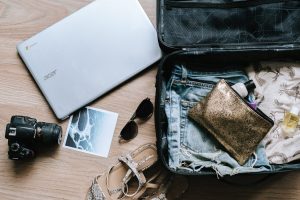 Budgeting for a Trip
Budgeting for a Trip
I’ve talked about finance in this blog before, but today I wanted to go through the specific steps I go through when planning out and budgeting for a trip. I know sometimes the thought of taking a big, expensive trip can be a bit daunting, and there can be a fear of going over budget when you travel, so I’ve put together this guide for you on how to budget for a trip.
The planning stage
During this stage, you’ll want to decide where you’re going to go and how much everything is going to cost. I know that sounds like a big, daunting task, but don’t worry: you can figure it out in steps. I suggest keeping a spreadsheet where you keep track of costs. You can use Excel, but I suggest an online spreadsheet through Google Drive, which you can share and add to with your traveling companions.
 Here is what you are going to want to research:
Here is what you are going to want to research:
- First, pick your destination. Then, pick what time of year you will be visiting. Keep in mind certain destinations fluctuate in price throughout the year as many places have a high season and a low season. Figure out what month you’ll be going.
- Once you’ve got your destination and time of year in mind. You can start researching average flight prices during that time of year. Flight prices will fluctuate. But giving yourself an idea of what range your airline tickets will be in will give you a general idea of your flight budget. Write that number down.
- Also research prices on accommodations in your destination at the time of year you will be visiting. Decide what kind of place you want to stay in. Find out what area of the city you would like to stay.
- Find out average prices per night on accommodations and calculate a total accommodation price based on an average price per night times how many nights you will be staying for. Write that number down.
- Decide what other big expenses you will have on the trip. This can be things like car rental, train passes, any tours you plan on going on, etc. Add those things up and write that number down.
- Find out if there will be additional fees involved with your trip. This can be things like fees for a visa in certain countries, fees for passport renewal, etc. Write that number down.

- Determine a daily budget for things like food, souvenirs, etc. Calculate how much you will need for the entirety of your trip at that budget, and write that number down. Keep in mind the kind of place you’re traveling to when you determine this budget and factor in things like exchange rates. For instance, it is going to cost you a lot more to eat every day in London than it is going to cost you in Thailand.
- Keep in mind that there are always going to be additional expenses that come up. Especially on a trip that you didn’t necessarily anticipate. This can be a fluctuation in the exchange rate, hidden fees at your hotel or car rental company, or just a discovery of something really awesome you didn’t know was there but that you really don’t want to leave town without doing.
- I like to budget extra money for these kinds of expenses. How much you set aside is really up to you and depends on your destination. But remember to set aside some “flex” money for these kinds of expenses. Write that number down, too.
Now that you’ve written down all these things, add them all up. That will be the rough budget for your trip. This is the amount of money you want to save.
 Saving
Saving
You can approach saving for a trip in one of two ways.
- The first way is to take your budget, set a deadline for yourself, and calculate how much money you need to save per pay period in order to accomplish your goal by your travel date. For example, if your trip is going to cost $5000 and you have 12 months before the trip in which to save, you would want to divide $5000 ÷ 12. For this trip, you would need to save about $417 per month in order to reach your goal. This way of saving works well if you have more money to play with and can, therefore, set aside more money per month, or if you set your target date farther into the future.
- The second way is to save what you can every month. For this method, you just set aside whatever you can each time you get paid or get some extra cash. This is usually the way I go about it, as it’s tough to save a set amount all the time as life often does get in the way. My rule with this kind of saving is that when the money goes into the account, it stays there and doesn’t get touched for any reason except for travel. I just save for as long as is necessary, and then when I have enough in the account, I start booking my trip.
 The purchasing stage
The purchasing stage
Once you’ve got your travel fund up to where it needs to be, it’s time to look into purchasing. At this stage, I like to look for deals. Just because the average flights at this time of year might be $500 round trip, but that doesn’t mean with a little searching I might not be able to find them for $350 round trip. Try to find ways to save money on all the things you book.
Look at airline websites, hotel sites, vacation rental sites, car rental sites, etc. and spend some time searching for the best deals you can. Try to stay on budget, but it’s even better if you can find something for under budget. Also, look at the price of booking things individually vs. packaged deals. Sometimes one can offer a better price than the other.
Book all your major costs at this stage. That’s the hotel, the airfare, the car rental, and any other big purchases you’ll be making on this trip. When you’ve done that, take a look at your budget and re-evaluate what your daily maximum is going to be. Also, keep saving right up until the day of the trip. The more you can save, the more you’ll be able to do when you get there.
 During the trip
During the trip
Stay on budget! Go under budget whenever possible. Try to spend money where it counts (meaning…on things you really want to do). Make sure to enjoy yourself, though. I like to do things like saving money on some meals by eating cheaply from the grocery store and then saving more of my budget for those really extravagant meals I definitely don’t want to miss out on.
Try not to put too much on your credit card that you can’t pay off immediately out of your trip budget. You don’t want to get yourself into debt. Sometimes the temptation can be great when you’re in the moment, but do whatever you can to stay on budget. Only charge things that you absolutely need to.
 After the trip
After the trip
Hopefully, at this point, you’ve had a fabulous time and stayed on the budget the whole time. Chances are, however, that you may have ended up with some extra money on your credit card during the trip. It happens to the best of us. Make sure you make paying off that credit card debt a priority though.
You may need to forego a few luxuries or cut costs for a little while after your return so you can allocate more money to paying it off. Try to pay more than the minimum payment, and pay off as much as you can possibly afford to at a time. Once any trip debts are paid off, now you can start planning your next trip.
Travel anywhere. Travel everywhere with Cleartrip
 Cleartrip offers the single most comprehensive travel experience to travelers and with the largest selection of flights, hotels and trains. Cleartrip.com keeps customers at the center of everything and you can find the lowest fare available and travel anywhere in the world.
Cleartrip offers the single most comprehensive travel experience to travelers and with the largest selection of flights, hotels and trains. Cleartrip.com keeps customers at the center of everything and you can find the lowest fare available and travel anywhere in the world.






